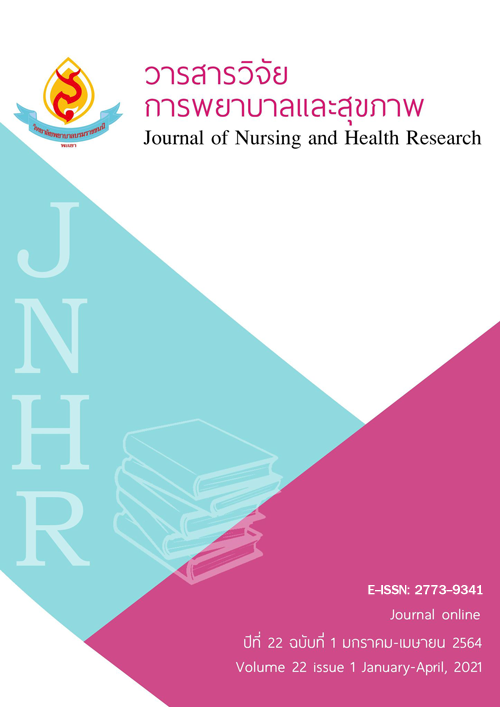ปัจจัยที่มีความสัมพันธ์กับพฤติกรรมการดูแลตนเองของผู้ป่วยโรคมะเร็งตับ ในโรงพยาบาลแห่งหนึ่งในกรุงเทพมหานคร
คำสำคัญ:
มะเร็งตับ, ระยะไม่ลุกลาม, พฤติกรรมการดูแลตนเองบทคัดย่อ
สถิติการป่วยจากโรคมะเร็งทั่วโลก พบว่าโรคมะเร็งตับพบมากเป็นอันดับต้นๆและยังเป็นสาเหตุการเสียชีวิตที่พบได้บ่อย การวิจัยครั้งนี้เป็นการวิจัยภาคตัดขวาง มีวัตถุประสงค์เพื่อศึกษาปัจจัย ที่มีความสัมพันธ์กับพฤติกรรมการดูแลตนเองของผู้ป่วยโรคมะเร็งตับ กลุ่มตัวอย่างในการศึกษาคือ ผู้ป่วยที่ได้รับการวินิจฉัยว่าเป็นโรคมะเร็งตับระยะไม่ลุกลาม ที่เข้ามารับบริการตามนัดที่คลินิกรังสีร่วมรักษาโรคตับ ณ โรงพยาบาลแห่งหนึ่ง ในจังหวัดกรุงเทพมหานคร จำนวน 177 คน เครื่องมือที่ใช้ในการวิจัยเป็นแบบสอบถาม ปัจจัยส่วนบุคคล ปัจจัยการรับรู้ความสามารถในการดูแลตนเอง ปัจจัยการได้รับแรงสนับสนุนทางสังคมและพฤติกรรมการดูแลตนเอง วิเคราะห์ข้อมูล ด้วยค่าสถิติ จำนวน ร้อยละ ค่าเฉลี่ย ส่วนเบี่ยงเบนมาตรฐาน และวิเคราะห์ความสัมพันธ์ด้วยสถิติทดสอบไคสแควร์ การทดสอบฟิชเชอร์ และสัมประสิทธิ์สหสัมพันธ์แบบเพียร์สัน ผลการศึกษาพบว่า กลุ่มตัวอย่างส่วนใหญ่มีพฤติกรรมการดูแลตนเองที่เหมาะสมมากร้อยละ 63.40 และพบว่าเพศ อายุ ระดับการศึกษา อาชีพ รายได้ สถานภาพสมรส ระยะเวลาการเจ็บป่วย และประวัติการเจ็บป่วยในครอบครัว มีความสัมพันธ์เชิงบวกกับพฤติกรรมการดูแลตนเอง การรับรู้ความสามารถในการดูแลตนเองโดยรวมมีความสัมพันธ์เชิงบวกกับพฤติกรรมการดูแลตนเองอย่างมีนัยสำคัญทางสถิติที่ระดับ p<0.01 (r=0.276) และ แรงสนับสนุนทางสังคมโดยรวมมี ความสัมพันธ์เชิงบวกกับพฤติกรรมการดูแลตนเองอย่างมีนัยสำคัญทางสถิติที่ระดับ p<0.01 (r=0.207) ดังนั้น ควรสนับสนุนให้ผู้ป่วยมีการรับรู้ถึงความสามารถในการดูแลตนเอง พร้อมทั้งการสนับสนุนทางอารมณ์และข้อมูลข่าวสาร ซึ่งจะทำให้ผู้ป่วยสามารถนำไปดูแลตนเองได้อย่างต่อเนื่อง
เอกสารอ้างอิง
ชมรมโรคตับแห่งประเทศไทย. (2544). ความรู้โรคตับสำหรับประชาชน. กรุงเทพฯ: สินทรัพย์การพิมพ์.
สกุลรัตน์ เตียววานิช. (2545). ความสัมพันธ์ระหว่างปัจจัยส่วนบุคคล ความพึงพอใจในบทบาทการดูแลเด็ก การรับรู้ภาวะสุขภาพ การสนับสนุนทางสังคม กับความผาสุกของผู้สูงอายุ เขตกรุงเทพมหานคร. (วิทยานิพนธ์ปริญญามหาบัณฑิตพยาบาลศาสตร์). กรุงเทพฯ. จุฬาลงกรณ์มหาวิทยาลัย.
สถาบันมะเร็งแห่งชาติ กรมการแพทย์ กระทรวงสาธารณสุข. (2561). ทะเบียนมะเร็งระดับโรงพยาบาล พ.ศ. 2560. กรุงเทพฯ: พรทรัพย์การพิมพ์.
สถาบันมะเร็งแห่งชาติ. (2556). แผนการป้องกันและควบคุมโรคมะเร็งแห่งชาติ (พ.ศ. 2556-2560). กรุงเทพฯ: โรงพิมพ์ชุมนุมสหกรณ์การเกษตรแห่งประเทศไทยจำกัด.
สมาคมโรคตับแห่งประเทศไทย. (2558). แนวทางการดูแลผู้ป่วยมะเร็งตับในประเทศไทย ปี พ.ศ. 2558. นนทบุรี: ภาพพิมพ์.
สำนักงานกองทุนสนับสนุนการสร้างเสริมสุขภาพ. (2562). แผนการรายงานการสร้างเสริมสุขภาพประจำปี. กรุงเทพฯ: ทวีการพิมพ์.
สุรชัย มณีเนตร และชนกพร จิตปัญญา. (2557). ปัจจัยสัมพันธ์กับคุณภาพชีวิตของผู้ป่วยมะเร็งตับและ ท่อน้ำดี. วารสารมหาวิทยาลัยนราธิวาสราช นครินทร์, 6(2), 24-35.
สุรชัย มณีเนตร. (2556). ความสัมพันธ์ระหว่างปัจจัยส่วนบุคคล อาการ การจัดการกับอาการ ความเข้มแข็งใน การมองโลก และคุณภาพชีวิตของผู้ป่วยมะเร็งตับและท่อทางเดินน้ำดี. (วิทยานิพนธ์ปริญญามหาบัณฑิต). กรุงเทพฯ. จุฬาลงกรณ์มหาวิทยาลัย.
อังกฤษ มีจักร. (2554). ความสัมพันธ์ระหว่างการรับรู้ความสามารถในการดูแลตนเอง การสนับสนุนทางสังคมกับพฤติกรรมการดูแลตนเองของผู้ป่วยมะเร็งศีรษะและคอที่ได้รับรังสีรักษา. (วิทยานิพนธ์ปริญญาวิทยาศาสตรมหาบัณฑิต). กรุงเทพฯ. มหาวิทยาลัยมหิดล.
Bandura, A., & National Institution of Mental Health. (1986). social Learning theory. Social foundations of thought and action: A social cognitive theory. Prentice-Hall.
Daniel W.W. (2005). Biostatistics: A foundation for analysis in the health sciences (8thed.). NJ: John Wiley & Sons.
Foster, C., Breckons, M., Cotterell, P., Barbosa, D., Calman, L., Corner, J…Smith, P. W. (2015). Cancer survivors' self-efficacy to self-manage in the year following primary treatment. Journal of Cancer Survivorship: Research and Practice, 9(1), 11–19.
Sauerland, C., Engeking, C., Wickham, R. & Pearlstone, D. B. (2009). Cancer of the pancreas and hepatobiliary system. Seminar in Oncology Nursing, 25, 76-92.
Schuppan, D., & Afdhal, N. H. (2008). Liver cirrhosis. Lancet. 371(9615): 838-51
Schaefer, C. (1985). Social support and health. Health Education Quarterly, 12(1), 109-112
Speak, D. L., Cowart, M. E., & Pellet, K. (1989). Health perceptions and lifestyle of the Elderly. Research in Nursing and Health, 12, 93-100.
Tamayo, A., Shah, S. R., Bhatia, S., Chowdhury, A., Rao, P. N., Dinh, P, Sarin, S. K. (2016). Correlates of disease-specific knowledge among patients with chronic hepatitis B or hepatitis C infection in India. Hepatology International, 10(6), 988–995.
ดาวน์โหลด
เผยแพร่แล้ว
รูปแบบการอ้างอิง
ฉบับ
ประเภทบทความ
สัญญาอนุญาต
ลิขสิทธิ์ (c) 2021 วารสารวิจัยการพยาบาลและสุขภาพ

อนุญาตภายใต้เงื่อนไข Creative Commons Attribution-NonCommercial-NoDerivatives 4.0 International License.



